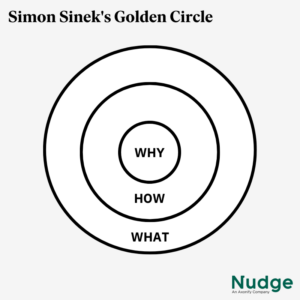My take on driving discretionary effort was inspired by Simon Sinek. In his classic TED Talk, How great leaders inspire action, Sinek explained the way we all think, act, and communicate using the “Golden Circle,” where “what” is on the outside, then “how,” and in the center is “why.”
 “Every single person, every single organization on the planet knows what they do, 100 percent. Some know how they do it, whether you call it your differentiated value proposition or your proprietary process or your USP. But very, very few people or organizations know why they do what they do,” explains Sinek.
“Every single person, every single organization on the planet knows what they do, 100 percent. Some know how they do it, whether you call it your differentiated value proposition or your proprietary process or your USP. But very, very few people or organizations know why they do what they do,” explains Sinek.
“As a result, the way we think, we act, the way we communicate is from the outside in, it’s obvious. We go from the clearest thing to the fuzziest thing. But the inspired leaders and the inspired organizations – regardless of their size, regardless of their industry – all think, act and communicate from the inside out.”
In other words, they start with why.
That resonated with me. Baking the “why” into employee communications is such a critical part of what we’re doing at Nudge. We’re constantly working with customers to help them go beyond the standard internal memo to drive better knowledge retention and engagement among their frontline staff.
And that engagement portion is key. Our The Deskless Report research found that having a sense of purpose or meaning at work makes 55% of frontline employees feel engaged and motivated at work. And particularly as frontline organizations adapt to the labor market right now, they’re trying to find the right brand presence to attract talent – and also build the right brand promise and work experience to retain them.
But on top of that, frontline organizations, particularly in retail, hospitality, and foodservice, are in rebuild mode. They’re up against a perfect storm, with supply chain delays and shortages, changing consumer behavior, and many other challenges. And while finding and retaining staff is part of the solution, a much bigger effort should be placed on empowering existing staff to go the extra mile. Because if you have your staff on board, collectively working to drive your core mission, increase revenue, and constantly deliver next-level customer and guest experience… you’re going to jump leaps and bounds in front of the competition. And that’s the magic of discretionary effort.
I first came across the phrase discretionary effort last year in a CX webinar with the amazing Rachel Huckle, Chief Retail Officer at Staples Canada. She talked about leveraging discretionary effort to pivot Staples Canada during the pandemic:
“My objective is not to drive discretionary effort. My interest is creating a culture and an environment where people want to give you discretionary effort and for me, that comes to life in communication and transparency. And that means, you know, one of the things I think throughout this pandemic that has been really, really powerful.”
So I have Simon Sinek and Rachel Huckle to thank for getting me to this idea of how to drive discretionary effort. Like the golden circle, it’s got three key stages:
- Culturally inspire
- Strategically align
- Tactically enable
And also like with Sinek’s golden circle, a lot of organizations don’t approach them in the right sequence. Here’s what I think is the winning approach:
Discretionary effort stage 1: Culturally inspire
You have to first start by culturally inspiring frontline employees. This is the “why” – why your staff should care about their job, why they should want it to succeed. This is about capturing the hearts and minds of your workforce.
This can be tricky. Some frontline organizations we work with employ hundreds of thousands of workers. How do you inspire them to fall in love with the brand that they choose to work for, so that they care about their job, the brand, and the customer experience? How, in other words, do you transform an entire workforce into brand advocates?
Culturally inspiring your workforce is about setting them up to thrive with the employee experience they want. For example, according to The Deskless Report, one of the most critical things your staff wants is a sense of purpose. You need to find ways to communicate your mission and values across your organization. Bake that messaging into everything – your internal communications, your pre-shift team huddles, everything. It shouldn’t be something you review once a year – it should be embedded into everything you do, so that if you approached any worker at any time and asked them what their company’s core mission is, they should be able to tell you.
Discretionary effort stage 2: Strategically align
The second stage is strategically align. You’ve already given your staff a sense of purpose around the brand they work for – now we’re going deeper into the specific role that they play in the grander picture.
So let’s say you’re a store cashier. And then at the very top of the retailer’s hierarchy, you have the CFO caring about growth, margins, costs, and strategy. That store cashier has a critical role to play in executing on that vision and growth story, and driving all those key deliverables the CFO is thinking about.
So strategically align is all about finding the right way for any individual in the business to recognize the impact of their role on the broader organizational strategy. Like, if you just ask someone to smile when they collect money at the cash register, they’re just going to collect money. But if you explain to them why it’s important to deliver a memorable and positive customer experience, and the impact that has on the broader goals of the organization, that cashier is far more likely to go above and beyond.
Discretionary effort stage 3: Tactically enable
In stage 1, we’ve inspired a frontline worker to care about what happens to their organization. In stage 2, we’ve shown them exactly what role they can play to help their organization succeed. Tactically enable is about then showing them exactly what’s expected of them to deliver the impact we’ve shown them is possible.
In the past, this would mean managers asking staff to get work done, and hoping they do it properly at the right time. Of course, that’s not an effective way to drive performance and operational consistency at scale – and it puts a huge load on the managers’ shoulders. That’s where frontline enablement tools come into play. Using a tool like Nudge for task management, organizations can assign tasks at a global, regional, location, or individual level – and monitor task completion at scale.
When you start to scale up the process to be standardized across every single location, you start to unlock operational consistency. And when you make it easy for workers to complete those standardized tasks, you unlock discretionary effort.
It’s about making it easy for people to get the right work done the right way, the first time. If someone has to put less effort into completing a task, but still delivers a consistently strong outcome, they’re more likely to do that.
—
These are unprecedented times. Labor shortages, supply shortages, food prices… there is so much out of our control. But the one thing that frontline organizations can control is their people. And tapping into the magic of discretionary effort is going to make or break organizations in the years to come.

